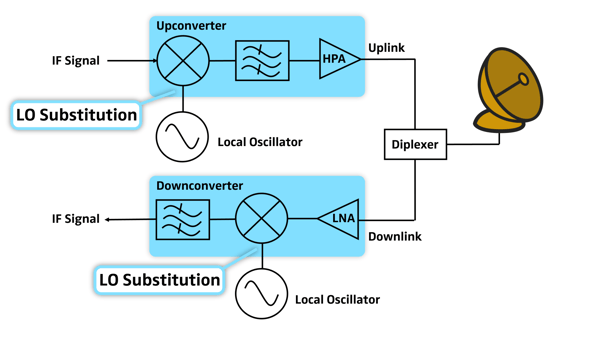Hosted in Washington, DC, SATELLITE 2024 is a premiere conference for the global space and...
Local Oscillator Substitution – Why Is It Important for Testing Satellite Systems?
Orbiting the Earth right now is a trove of satellites, many of which are in low-earth Orbit (LEO) operating no more than 1,200 miles above Earth’s surface. Providing low latency communications, LEO satellite deployments show no signs of slowing down.
Local Oscillators in Satellite Systems
 Oscillators are components that produce repetitive, oscillating signals, such as sinusoidal waves. A local oscillator is a type of oscillator that uses its output to modify signals, such as those used in a satellite system’s uplink and downlink chains. The output from the LO and the uplink or downlink signal are fed into a mixer to create the new desired frequency for various forms of processing.
Oscillators are components that produce repetitive, oscillating signals, such as sinusoidal waves. A local oscillator is a type of oscillator that uses its output to modify signals, such as those used in a satellite system’s uplink and downlink chains. The output from the LO and the uplink or downlink signal are fed into a mixer to create the new desired frequency for various forms of processing.
Let’s review the role of an LO in the uplink and downlink paths of a satellite ground station/gateway, which are Earth-based stations that provide communications with satellites.
- Uplink: A satellite uplink consists of the signal’s path from the ground station/gateway to the satellite. LOs help with the upconversion process, where a signal at a lower frequency (data signal intended for transmission) is converted to a higher frequency.
- Downlink: A satellite downlink consists of the signal’s path from the satellite to the ground station/gateway. LOs are used during the downconversion process, where a signal at a higher frequency (received signal) combines with the LO output to create a lower intermediate frequency (IF) for signal processing and data recovery.
Beyond ground stations/gateways, LOs are also used onboard satellites and in user terminals, which offer a direct user-to-satellite connection.
Testing Local Oscillator Performance
An effective way to discover whether the LO is the source of a fault is to remove its influence from the system and replace it with a high-performance signal generator, such as the Boonton SGX1000 Series. LO substitution enables engineers to:
- Uncover if performance issues are caused by the LO itself.
- Maintain the integrity of satellite up/downconverter chain evaluation by removing LO characteristics from results.
- Test up and downconversion chains prior to availability of the system LO.
Frequency accuracy, frequency resolution, and amplitude accuracy are all basics specifications to consider when choosing a signal generator as an LO substitute. An additional parameter to consider is the purity of the output signal in terms of phase noise.
LOs contribute various levels of phase noise into the system, which are random fluctuations in the phase of the signal. Excessive phase noise, especially in higher-order modulation schemes, can severely impact signal quality and increase bit error rate (BER).
It’s important, therefore, that the signal generator chosen as an LO substitute produces signals with low phase noise levels. The Boonton SGX1000 Series, for example, offers ultra-low phase noise performance (-122 dBc/Hz signal sideband phase noise at 3 GHz and 10 kHz offset), enabling effective LO substitution for satellite systems.
Watch Now: SGX1000 Series Demonstration
At IMS 2023 in San Diego, California, Wireless Telecom Group featured the capabilities of the SGX1000 Series in a live demonstration, highlighting in particular its fast-switching speed of 350 µs. LO substitution in frequency-agile satellite communications systems, which shift between different operating frequencies, require signal generators that can sweep various frequencies and amplitudes quickly for efficient testing. In the video below, revisit the IMS show floor and see the SGX1000 Series in action.





